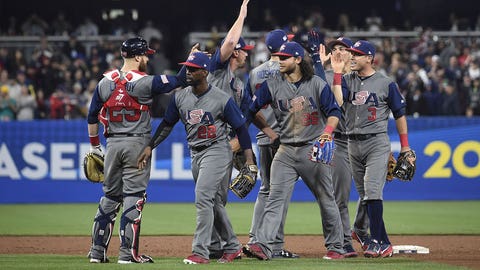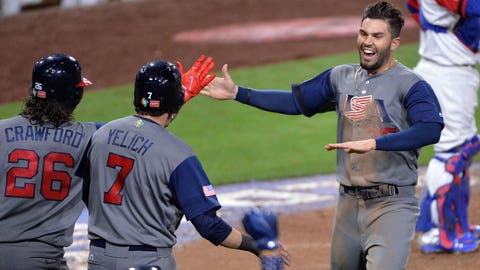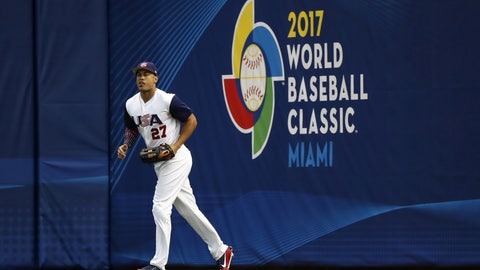LOS ANGELES — The first night they were together, earlier this month in Ft. Myers, Fl., a group of Team USA hitters went out to dinner.
Marlins outfielder Christian Yelich, 25, and Astros infielder Alex Bregman, 22, were the youngest of the six players who attended.
“I got more out of that than I’ve gotten from anything in a long time,” Bregman told Yelich.
Yelich replied, “Yeah, it’s like getting a master’s degree in hitting.”
Or, as Bregman said recently, “It was something that an average person would pay a lot of money for, to sit at that table and listen to (Paul) Goldschmidt and (Giancarlo Stanton) and (Nolan) Arenado talk about hitting for three hours.”

Nationals second baseman Daniel Murphy was the other player in attendance, and the conversations didn’t end that night.
They’ve continued throughout the World Baseball Classic, in dugouts and clubhouses, on buses and planes — everywhere Team USA has gone, from Ft. Myers to Miami to San Diego and on Tuesday night, to the semifinals of the tournament at Dodger Stadium against Japan.
The Angels’ Mike Trout, Nationals’ Bryce Harper, Cubs’ Kris Bryant and the rest of the hitters who declined invitations to join Team USA did not simply miss out on the chance to play for their country.
They’ve also missed out on the brainstorming sessions that a number of team members view as one of the most rewarding aspects of participating.
Yelich called it, “one of the cooler, overlooked aspects of the WBC.” Several Team USA players noted that the team is full of “baseball rats” who share a relentless passion for the game and unquenchable desire to improve — in part, by studying each other.

“The main reason to come play obviously was to represent the United States. But the second was literally because I wanted to play with some of these ballplayers, see what I can learn from them,” Arenado said. “To be here and learn from these guys, it’s been a big deal, a huge, huge thing for me.”
Goldschmidt agreed, pointing out that his favorite part of the All-Star Game is his interactions with other players. The WBC is an extended version of that experience, lasting more than two weeks for teams that advance to this point.
The players share and exchange so much more at this event, watching each other work in the cage, watching each other’s at-bats, talking about different pitchers, explaining how they formulate plans.
“It’s much different than the All-Star Game,” Stanton said. “In an All-Star Game, you’re in full stride. You’re almost resting a little bit because it’s your only down time in the long haul of a season.
“This is actually preparing yourself to be the best for the year, and to win this (tournament) also. You get to see everyone’s routine, the focus of all these guys, why these guys are MVPs and All-Stars every year.”

That’s how many of the players talk — as if they’re just regular guys, and it’s the others who are elite. Their humility is not an act. As much as fans find it difficult to comprehend the players’ skills, the players hold each other in similar high regard.
Take Murphy, for example.
Team USA players asked him, how did you emerge as one of the game’s best hitters last season at age 31? What did you change?
“One of the biggest things is that I just tried to hit the ball in the air,” Murphy said. “But then when I talk to Buster (Posey) and Paul and Nolan, they already did such a great job of driving the ball their entire careers.
“I was more or less OK if I hit a low line drive or groundball. I wasn’t always looking to do damage. Once we ended up talking for just a little bit, I came to the realization that I’m now trying to do what they’ve been doing for their entire careers.”

Along the same lines, several hitters said they drew comfort from hearing others talk about how they handle slumps — the slumps that are inevitable even for the game’s best.
Stars are just like us: They have insecurities too!
“It’s a lot of stuff you’ve heard before,” Goldschmidt said. “But just to hear the best guys in the game say it, it kind of reinforces, ‘Hey, remember that. Keep doing that.’ There’s not some secret sauce. Simple is usually better.”
Added Arenado: “Sometimes we think that we need to think a certain way when at the end of the day we don’t. There are so many different ways to hit, so many different thought processes that can work. It’s interesting to hear it. It helps a lot.”
Posey, 30, is a nine-year veteran and three-time World Series champion with the Giants. But when asked if he is benefiting from talking to other Team USA hitters, he replied, “No doubt.”

For Posey, it’s a matter of discovering what makes each player tick, then selecting bits and pieces from those players and incorporating them into his own process.
“One of the most important qualities of a baseball player is being able to filter — taking in information and filtering it through, saying this is something that works for me or this isn’t something that works for me as well,” Posey said.
“Sometimes younger players run into a little bit of trouble. Just because I say, ‘This is the way I do it,’ doesn’t mean it’s going to work for you. You have to have enough awareness of yourself to know, ‘I’m not going to hit like Arenado. I don’t necessarily have the same path or swing. But at the same time, maybe it’s a mindset that he uses that I can apply at the plate.’”
Bregman, the baby of the group, is simply soaking it all in. He converses with Arenado about playing third base and the Giants’ Brandon Crawford about playing shortstop. When the veteran hitters talk, he said he is content to listen, acting as “a fly on the wall.”
“It’s a really fun team to be a part of,” Bregman said. “You get to pick different guy’s brains every single day, see what makes them tick, see what makes them the players they are.”
It’s a benefit for players who accept the invitation to join Team USA.
If you’re Trout, Harper or Bryant, why wouldn’t you want to be a part?





